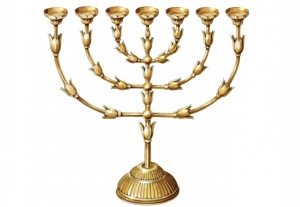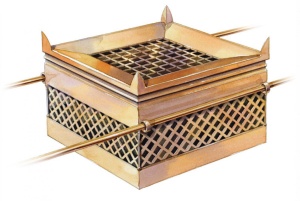Pictures from The ESV Study Bible
Courtyard
Tent
Altar of incense
Lampstand
Table Bread
Bronze Altar
Priestly Garments
Ark of Covenant
Every piece of furniture in the Tabernacle would symbolize the nature of God. Gold symbolized God’s deity and worth; Purple symbolized God’s royal kingship, Scarlet symbolized the need for atonement or sacrifice; Oil/incense/spices symbolized fragrant worship; Lampstands symbolize light and God’s Spirit; Water in the basins would symbolize the need for cleansing of sin; and Bread on the tables symbolized God’s fellowship to eat among His people; Veils/Curtains to separate the rooms of the Tabernacle symbolized the division of flesh and Spirit; the entrance to the to the Tabernacle court faced East (Ex 27:13, 38:13) like God placed cherubim with flaming swords to guard the entrance in Eden (Gen 3:24). Inside the Most Holy Place of God’s presence would be the testimony of the Law (10 Commands) approached only after a sacrifice on the mercy seat (Ex 40:20) just as in Heaven is restored back in the center the tree of life (Revelation 22:22).
Hebrews 8:1-13
Tabernacle was a picture of Eden (Exodus 25:8; 40:1-34)[1]
The Bible shows us God existing in perfect harmony on His own and yet creating the world with humanity so He can be among us. He plants a garden in Eden and places humanity inside it (Genesis 2:8, 15). It was good, beautiful (tob) and delightful (Eden). This was God’s design for creation.
However, humanity rejected God’s presence. They rebelled and drifted away from God’s purposes. They did life their own way without God. The Lord provides grace and calls out a people unto Himself with Abraham. Onward through these generations God promises to lead them into a land filled with His presence and blessing (Genesis 12:1-2).
The book of Exodus shows us that God is faithful to care for and lead His people. Even though Israel was overpowered and enslaved to the Egyptians, God rescued them. In this new land and journey God gives them His commands and instructions to build a Tabernacle. It would be a sanctuary or home for God to dwell in their midst; a mini-Eden.
Around Eden flowed rivers that led to gold, bdellium and onyx stone (Gen 2:11-12). Likewise, these are materials and elements which the Tabernacle would be built (Exodus 25:3-8). Just as God created Eden with skill and significance, so God would command workers to do the same with the Tabernacle. Bezalel (name means: in the shadow of El/God) and Oholiab (name means: tent of my father) would build the Tabernacle with the supplied materials.
Every piece of furniture in the Tabernacle would symbolize the nature of God. Gold symbolized God’s deity and worth; Purple symbolized God’s royal kingship, Scarlet symbolized the need for atonement or sacrifice;Oil/incense/spices symbolized fragrant worship; Lampstands symbolize light and God’s Spirit; Water in the basins would symbolize the need for cleansing of sin; and Bread on the tables symbolized God’s fellowship to eat among His people; Veils/Curtains to separate the rooms of the Tabernacle symbolized the division of flesh and Spirit; the entrance to the to the Tabernacle court faced East (Ex 27:13, 38:13) like God placed cherubim with flaming swords to guard the entrance in Eden (Gen 3:24). Inside the Most Holy Place of God’s presence would be the testimony of the Law (10 Commands) approached only after a sacrifice on the mercy seat (Ex 40:20) just as in Heaven is restored back in the center the tree of life (Revelation 22:22).
The Tabernacle was a mini-Eden, with the Creator present dwelling among His people!
Ex 40:34 “the glory of the Lord filled the tabernacle”
Today, we do not need to build a Tabernacle or enter a church building to experience God’s presence.
Jesus is the true tabernacle.
John 1:14 tells us that “the Word became flesh and dwelt [Gk. σκηνόω] among us,”
Jesus became the God-man he “tabernacled” among us. (And of course Jesus spoke about “the temple of his body” [John 2:19, 21], and Paul taught that because we are united to the risen Messiah “our bodies are the temple of the living God” [2 Cor. 6:16].)
Jesus’ body is the curtain ripped in two that brings us to the holy presence of God.
“Therefore, brothers, since we have confidence to enter the holy places by the blood of Jesus, by the new and living way that he opened for us through the curtain, that is, through his flesh. . . .” (Heb. 10:19-20). (See also Matthew 27:51: “the curtain of the temple was torn in two, from top to bottom.”)
Jesus is the full and final sacrifice.
“Behold, the Lamb of God, who takes away the sin of the world!” (John 1:29).
“. . . We have been sanctified through the offering of the body of Jesus Christ once for all. . . . Christ had offered for all time a single sacrifice for sins . . . By a single offering he has perfected for all time those who are being sanctified.” (Heb. 10:10, 12, 14)
Jesus is the great high priest over the house of God.
“. . . and since we have a great priest over the house of God, let us draw near with a true heart in full assurance of faith, with our hearts sprinkled clean from an evil conscience and our bodies washed with pure water.” (Heb. 10:21-22)
Tabernacle was a portable house for God (Ex 40:35-38)
As the building was complete the fulfillment of God’s promises were coming about. God promised to bring them out of Egypt and up to a new place where He would be with them (Ex 3:7-12, 6:2-8, 25:8, 29:43-46). The Tabernacle housed the presence of God but it was not a permanent home. Israel would be on a journey following God’s presence. When the cloud of God’s glory was taken up they would travel, and when the cloud was set the people stayed.
Israel thought they could keep God in a box with the ark and use Him as token but they were defeated by the Philistines who captured the ark (1Samuel 4-5).
King David sought to build a house for God and the Lord responded His house was eternal
2Samuel 7:6-7 “I have not lived in a house since the day I brought up the people of Israel from Egypt to this day, but I have been moving in a tent for my dwelling. In all the places where I have moved with all the people of Israel did I… [ever ask] ‘Why have you not built me a house of cedar?”
Solomon recognized that any house on earth would only be temporary
1Kings 8:27 “But will God indeed dwell on the earth? Behold, heaven and the highest heaven cannot contain you; how much less this house that I have built?”
And Paul,
Acts 17:24 “God made the world and everything in it, being Lord of heaven and earth, and does not live in temples made by man”
What does this mean for us today?
ð God is on the move. Let us not try to box in and keep Him to ourselves. Let us open the doors and windows and be SENT out to share the light and love of Christ unto the world.
Tabernacle was a priestly reminder of our need of grace
The Lord instructed Moses about the Tabernacle and the priestly garments WHILE the Israelites were committing idolatry (Ex 25-32). THEN, following condemning their idolatry, the Lord allowed Moses to follow through with the building of Tabernacle and the design of the garments for Aaron to wear & use as a priest.
This is nothing but grace and mercy. The Tabernacle would stand as a tangible reminder to Moses, Aaron and the people of God that though they deserved judgment they received grace.
Think about it,
– What came to Aaron’s mind when he put on the garments? Did he feel shame, humbled, forgiven, loved… YES and more!
– Likewise, when we enter the presence of God to worship and receive communion elements –
we feel undeserving but also unconditionally loved. We are reminded of 3 words: God loves me!








Tabernacle pictures http://www.kotipetripaavola.com/Tabernacle.html
Are these pics copyrighted? I would like to use some, like the Alter for Sacrifice, for a church setting, making 24 paper copies as a visual supplement to the teaching.
Thanks,
George
As posted, the source of the pictures is The ESV Study Bible: http://legacy.esvbible.org/Exodus+40/
For background information on the Tabernacle feel free to review my post: https://growinggodlygenerations.wordpress.com/2013/05/14/tabernacle-exodus-40/
Could I have permission to use some of your pictures of the Tabernacle pieces for a not for profit booklet I am putting together which teaches on prayer and the Tabernacle of Moses.
They are not my pictures to give permission. As posted, the source of the pictures is The ESV Study Bible: http://legacy.esvbible.org/Exodus+40/
Thank you a beautiful image to see just how beautiful the tabernacle was. God is good praise God🙏